- Submissions

Full Text
Developments in Anaesthetics & Pain Management
Brain Computer Interface: A future solution for Virtual Reality Navigation in Surgery Hands to Mind Control, Just Thinking
Jose Luis Mosso Vazquez1*, Angelica Torres Morales2 and Melissa Garcia2
1School of Medicine, Universidad Panamericana, Mexico
2Internal Medicine Residency Program, Mount Sinai Medical Center, USA
*Corresponding author: Jose Luis Mosso Vazquez, School of Medicine, Universidad Panamericana, Mexico
Submission: July 25 2018;Published: September 27, 2018

ISSN: 2640-9399 Volume1 Issue5
Summary
Outpatient´s mind could control virtual Reality scenarios in the future just with his will, during ambulatory surgery with a Brain Computer Interface BCI technology. Up today we need our finger´s hands to control a computer screen, we need our head and neck movements to control a smartphone ´screen into a cardboard for immersive 3D virtual navigation or Oculus technology. Brain Computer Interface BCI is an innovative technology that has the proposal to introduce and extracts data information from the human Brain in lab and demonstrated in clinical trials with progressive results. Brain Computer Interface is a useful, innovative device with the possibilities in the future to perform virtual Reality navigations inside the brain using just the human mind. During outpatient or ambulatory surgery many patients cannot move their bodies, their arms, hands, and heads and so on. In this article we review our experience with VR in surgery and describe traditional technologies to control VR scenarios and we discuss the possibilities to use emergent technologies to reduce pain and anxiety while surgeon is performing surgeries.
Keywords: Brain machine interface; Cyber therapy; Ambulatory surgery
Introduction
In the last ten years we have used VR systems for reduce pain and anxiety in different urban and indigenous regions in Mexico [1,2] such as colposcopy in Gynecology [3], ambulatory surgery [4], cardiac surgery unit care [5-7], upper GI Endoscopy [8,9] and other different medical areas. Different computer technologies have been used as Laptops and PC. Different screens also as Head Mounted Displays HMD, glasses, screens from projectors, computer´s screens, smartphone´s screens, oculus´s screens. VR scenarios have been those developed for medicine use (Forrest, cliff final, developed by Benda and Mark Wiederhold from Virtual reality Medical center in San Diego CA), and commercials VR (Free VR apps for smartphones). Each patient´s group need their own VR system, it depends of body positions, the region or their lesions, right or left arm with intravenous catheter, the technique of medical or surgical procedure, age, gender, interest in technology, medicine specialty, if the patient is for private medicine attention or public.
The best scenario for adults and old ages has been those developed just for medicine applications because they relax patients. Not for children who enjoy better with serious games. The best device is those who can navigate with haptic devices as hand controllers in ambulatory surgery. The best screen with high resolution and immersion is from Oculus. Screen’s Smartphones usually don´t attach inside cardboards but well attached inside oculus. The optimal system for VR navigation in Medicine depends of the case to treat.
But in the future, the optimal VR system could be as follows: Real VR scenarios with high immersion without using HMD and computers, high capacity for navigation without using the body movements. These systems could be supported just with Brain Computer Interphase technology that permit patients introduce brain implants for VR navigation stimulating vision areas to appreciate VR scenarios inside patient´s brain. Pain could be controlled with deep microelectrodes placement in specific pain areas as thalamus with midbrain stimulate brain activity. Mark Wiederhold have experience with VR navigation with systems controlling scenarios just with the patient´s mind, just thinking, but the results are not satisfactory yet. Pain in the intraoperative and in the postoperative is one of many challenges in surgery. There are a lot of scientific and technological efforts to reduce it with robotics in Minimal Invasive Surgery, hibernation, energy, brain electrical stimulation, analgesics, anesthetics but it is not enough. BCI could be in the future a solution to reduce pain in surgery.
Emergent technologies for brain are being developed in many laboratories in the worldwide laboratories as DARPA, these projects are related with two wide areas: nanotechnology and brain computer interface BCI [http://www.humanconnectomeproject. org/]. With nanotechnology, neuroscience researchers have developed brain implants with two proposals; one is to extract information from the brain to be sending to a computer [10] and the second proposal is to send information to the brain from a computer [11]. Computer analyze brain information to translate these in motions, words, responses, etc. An example for the first application is to extract electroencephalogram information to a computer in locked in patients to dialogue with them with written words in a computer screen. Other BCI applications are to write on a screen just with the patient´s will and control one or many robot arms to help themselves and drink water. Electrical stimulation from a computer to the brain to stimulate specific areas to improve and modulate muscles in disabled patients is another example [12].
In the last example (To send information to the brain from a computer), researchers are rising human attention to perform accuracy task in battle fields (https://www.newscientist.com/ article/mg21328501-600-zap-your-brain-into-the-zone-fasttrack- to-pure-focus/) and why not to improve surgeon attention for surgeries? Other applications are considering introduce virtual reality scenarios inside specific brain areas as part of our vision without using our eyes, optic nerves and the patients will use only the vision areas and optic pathways in occipital lobes connected or involved with the rest of all the nervous system. These applications could be addressed for distraction or reduce somatic or visceral pain during ambulatory surgery using just a BCI. Furthermore, there exist the possibilities with the same application to navigate watching our own experiences using brain stimulation into specific memories areas as hippocampus where we can find our past life; this experience could be considered virtual Reality inside the brain when it is part of our life into our memory [13]. More application could be to block pain brain areas with electrical stimulation in thalamic nucleus to disappear somatic or visceral pain pathways avoiding with medication with this technique. There is experience related with Deep Brain Stimulation for Intractable Pain [14-16].
Up today, the current technology permits us, to use a computer and Head Mounted Display on the patients but they must use their fingers, head motions, hands control for Virtual navigation. In many cases, the assistant help users, manipulating the computer keyboard to move the virtual reality scenario and patient just watch. Similar patient´s experience have Using Google card boards, because they move their heads, necks for navigation, this is an uncomfortable positioning for patients laying down during surgery. A new Brain Computer Interface is Emotive’s device for mental Commands algorithm that recognizes patient´s thought that can be assigned to control virtual reality scenarios for virtual navigation just by thinking using 32 electrodes on the skull. Patient´s brain control can replace traditional input devices like keyboards, without move head, neck, fingers, hands, arms, enhancing interactive virtual experiences during surgeries. Emotive’s devices convert brain waves into digital signals that can be used to control anything that speaks in 1’s and 0’s.
Emergent BCI technologies will improve the capacity for virtual navigation in the future in the intraoperative and recovery and probably will disappear the surgical pain with medications. Probably computers or cell phones will be reduced in size that could be inside our brains as ordinary implants. Up today, cyber therapy uses VR (Out the brain) and it is a noninvasive device that work in the majority of patients as virtual anesthesia on patients underwent medical or surgical procedures. BCI technology will be the best method to disappear pain and anxiety during surgeries in the future (Figure 1-7).
Figure 1:Patient´s fingers controlling Virtual Reality Scenario laying down in the intraoperative using keyboard during cyst removing.
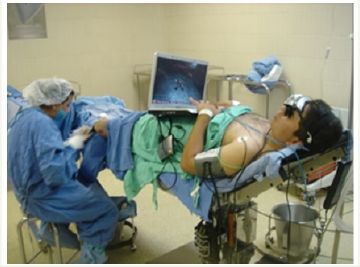
Figure 2:Anesthesiologist’s fingers controlling keyboard of a Laptop for VR navigation patient underwent bilateral and open hernioplasty with regional anesthesia and VR anesthesia.

Figure 3:Resident controlling VR navigation patient in the unit care in his postoperative cardiac surgery.

Figure 4:Tablet on patient´s hands for virtual navigation umbilical hernia repair.
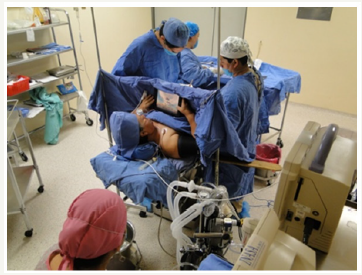
Figure 5:Head and neck patient´s motion to control VR on smartphone´s screen into a Cardboard Cleaning abdominal wall before to perform a cesarean.
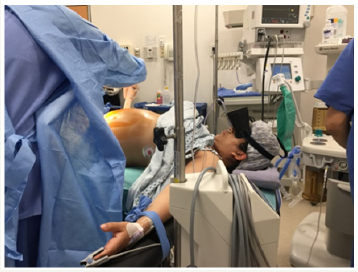
Figure 6:Indigenous patient without moving his arms, hands and finger during ambulatory surgery assistant is controlling VR navigation with a computer.
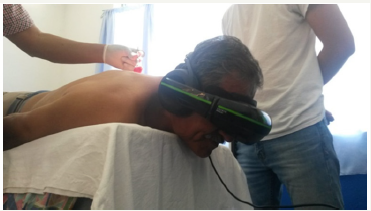
Figure 7:Brain implant.
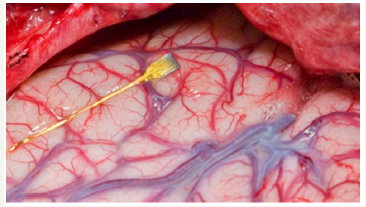
References
- Alessandra G, José LM, Dejanira M, Erika P (2009) Emotional response to virtual reality exposure across different cultures: The role of the attribution process. Cyberpsychol Behav 12(6): 699-705.
- José LM (2013) Cybertherapy In Medicine: Clinical applications to reduce pain and anxiety. Cybertherapy and rehabilitation 28(5).
- José LM, Brenda K, Wiederhold, Ian M (2017) Virtual reality pain distraction during gynecological surgery-A report of 44 cases. Surgical Research Updates Journal 5: 12-16.
- José LM (2013) Limits of virtual anesthesia in ambulatory surgery. Surgery Curr Res 3(4).
- José LM (2013) Cyber therapy to reduce distress in critical unit care of cardiac recovery surgery. Surgery Curr Res 3: 4.
- José LM, Amador S (2013) Using Cybertherapy to reduce postoperative anxiety in cardiac recovery intensive care units. Journal Anesth Clin Res 4(10): 307-312.
- Jose LM, Brenda W, Filippo La (2017) Study of gender differences in VR response following cardiac surgery. J Psychol Cognition 2(1): 67-71
- José LM, Brenda W, Ian M (2017) Virtual Reality assisted anesthesia during upper gastrointestinal endoscopy report of 115 cases. European Medical Journal Innovations 1(1): 75-82.
- José LM, Brenda W, Ian M, Dejanira M (2017) Virtual Reality Assisted Anesthesia (VRAA) during upper gastrointestinal endoscopy: Report of 115 cases. Analysis of Physiological Responses Surgical Research Updates Journal 5: 1-11.
- https://www.newscientist.com/article/mg21328501-600-zap-yourbrain- into-the-zone-fast-track-to-pure-focus/
- http://www.cns.nyu.edu/~david/courses/perception/lecturenotes/ speech/speech.htm12.
- https://splinternews.com/darpa-is-testing-implanting-chips-insoldiers- brains-1793851273
- https://www.youtube.com/watch?v=CgFzmE2fGXA.
- Krishna K, Cory T, Rahul N (1997) Deep brain stimulation for intractable pain: A 15-year experience. Neurosurgery 40(4): 736-747.
- Alim LB, Stephan C, John M (2009) Deep brain stimulation of the subthalamic nucleus for the treatment of Parkinson’s disease. Lancet Neurol 8(1): 67-81.
- Marwan IH (2002) Complications of deep brain stimulation surgery. Movement Disorders 17(3): 162-166.
© 2018 Jose Luis Mosso Vazquez. This is an open access article distributed under the terms of the Creative Commons Attribution License , which permits unrestricted use, distribution, and build upon your work non-commercially.
 a Creative Commons Attribution 4.0 International License. Based on a work at www.crimsonpublishers.com.
Best viewed in
a Creative Commons Attribution 4.0 International License. Based on a work at www.crimsonpublishers.com.
Best viewed in 







.jpg)






























 Editorial Board Registrations
Editorial Board Registrations Submit your Article
Submit your Article Refer a Friend
Refer a Friend Advertise With Us
Advertise With Us
.jpg)






.jpg)














.bmp)
.jpg)
.png)
.jpg)










.jpg)






.png)

.png)



.png)






